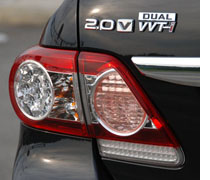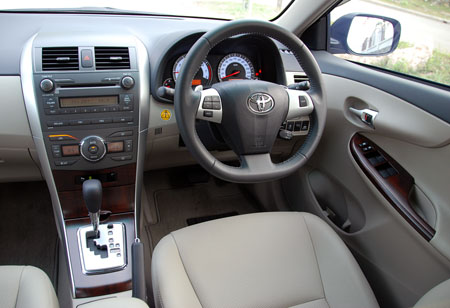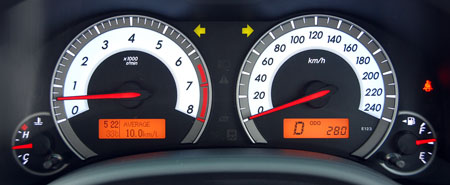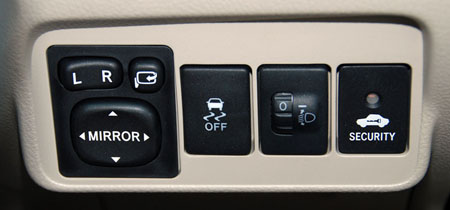collection of: http://jauhari-englishhomework.blogspot.com
A new ZR range of Dual VVT-i engines are now in place, and there’s a 2.0-litre range topper to join the 1.8 and 1.6. The new engines will be paired to another first for the Altis – a CVT gearbox with seven virtual ratios in manual mode (except the 1.6, which soldiers on with a 4-speed auto).
We’ve driven it already, when Toyota Asia Pacific organised a regional media drive for the new car at the Sepang circuit. And while we had a decent first impression, there’s only so much you can experience in a few runs, on a circuit. So here’s a more detailed review of the new Altis, in the exact same spec that will be launched in Malaysia.
I like what Toyota has done to the new Altis. In my opinion, the fresh face, in particular the new grille and reprofiled bumper, gives the car a wider look and erases the fussy sharp nose of the old car. Like the facelift for the Camry, the “U” shape of the front is ditched in favour of an “X” shape. Speaking of that car, the Altis now looks very much like a junior Camry; seeing how popular the Camry is, that can only be a good thing.
The HID headlamps have a greyish blue tint on their lenses (not apparent in pictures) which Toyota labels as “smoked”. They look good but less good looking in my opinion are the tail lamps, which have a whiff of aftermarket about them. At least they do the job of differentiating old and new from the back effectively. The other changes are a longer chrome strip above the number plate, new bumper with horizontal reflectors and the Dual VVT-i badge, which UMWT opted to put next to the variant badge.
 Those with “younger” and more sporty tastes will be attracted to the Civic or Lancer without even giving the Altis a look, but for the rest of the buying public, the Toyota should be entirely inoffensive, and maybe even a bit sporty in the case of the top spec 2.0V. Talking about sporty, it’s a nice rim design, but they’re still only 16-inch items and there’s no bodykit at launch.
Those with “younger” and more sporty tastes will be attracted to the Civic or Lancer without even giving the Altis a look, but for the rest of the buying public, the Toyota should be entirely inoffensive, and maybe even a bit sporty in the case of the top spec 2.0V. Talking about sporty, it’s a nice rim design, but they’re still only 16-inch items and there’s no bodykit at launch.As mentioned in our initial test drive at Sepang, Malaysian bound cars will have a light coloured cabin across the board, instead of the black that some markets get for their 2.0V. While there are some who don’t like this, a light hue has its benefits.

Besides creating a greater impression of space and airiness, the Altis interior feels luxurious the moment you step in. Although it isn’t greatly changed from the old model, the little differences make a positive difference. The grey soft plastics that line the top half of the dash and door mouldings are in a darker shade than before, and the faux wood trim is now in tasteful dark wood with a matte finish. For me, while the old orangey and shiny wood was a turn off, the new trim successfully warms the ambience over lesser models that have silver plastic.
Quality is top notch. Panel fit is exemplary, buttons are super tight fitting and good in tactile response. The only blot in the copybook is the fit of the second glove box in our test car, but then again, how many other classmates offer an extra glove box? The layout and ergonomics are also incredibly simple and straightforward – I can imagine my parents operating the car immediately without fumbling, for instance.
The most obvious changes in the cabin are the steering wheel and instruments, and both look good and work well. The three-spoke steering (only for the 2.0V) is a really nice thing to hold – perfect thickness, slightly flat bottomed, perforated leather with contrasting stitching and useful buttons. The DISP button on the right spoke toggles the trip meter while the cruise control is on a separate stalk. Personally, I like this layout as I use the trip computer more often than cruise control.

For the Optitron dials, they now sport a white ring with black numbers – looks sportier and is more legible than before. All models get a green ECO light that well, lights up when you’re light on the throttle. You can also call up an ECO meter from the trip computer if the former isn’t enough.
Other things I noted over the few days with the car are the abundance of little storage spaces (both sides of the centre console base, left one has a hook), the illuminated vanity mirrors (not that I used them much  ) and the handy sliding arm rest. I also realised that the controls for the wing mirrors are completely unsighted, blocked by the steering wheel. The seat base (driver gets electric adjustment with lumbar control) could have been longer too, although the leather covers weren’t as slippery as in the Sepang cars. The front parking sensors were quite useful too.
) and the handy sliding arm rest. I also realised that the controls for the wing mirrors are completely unsighted, blocked by the steering wheel. The seat base (driver gets electric adjustment with lumbar control) could have been longer too, although the leather covers weren’t as slippery as in the Sepang cars. The front parking sensors were quite useful too.

The Altis is a more mature sort of car, and that’s not a criticism. It majors on refinement and comfort, and delivers on the most part, except for the low speed ride. Toyota also wanted a plush luxurious feel with a dash of sport for their C-segment car, and we think that’s achieved nicely in the cabin.
If there was something that didn’t meet my expectations, it’s the fuel consumption. Driving smoothly with the ECO light on 80% of the time (it goes off in manual mode, by the way), my best efforts yielded 11.2 km/l according to the trip computer, which isn’t terrible, but not great for such a promising combo. Perhaps it could be that factory fresh WUJ 5552 had just 70 km on the odometer when we collected it, and economy would improve with more miles on the clock. Other issues? The fiddly key fob needs strong, deliberate presses to work and the alarm went off too often in a thunderstorm.
That aside, I can imagine the Altis as a satisfying car to own and use, but also a car that I’ll never lust after. A brilliant tool, nothing more. That’s a car’s role for many though, and the Altis’ new-found blend of great refinement and performance plus traditional Toyota qualities makes it stand out in a sea of“sporty” players.
log on to http://paultan.org/2010/ for more infirmationmore news at :http://jauhari-englishhomework.blogspot.com

No comments:
Post a Comment